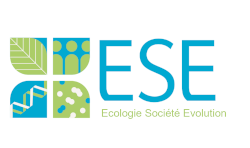A project developed recently in the team focuses on the study of the diversity and the domestication of the cheese Penicillium fungi, which are excellent eukaryotic models to understand the genomic processes of adaptation, thanks to their small genomes, the strong and recent selection exerted humans for known characters (color, metabolism,…), phenotypes that can be rather easily measured in vitro and the possibility of functional validation. Humans made cheeses since the Neolithic era, and the selection was accentuated and globalized more recently. These fungi thus constitute excellent models to understand the evolutionary mechanisms generating biodiversity, or reducing it, and to understand the mechanisms of rapid adaptation to a new environment.
We have analyzed the genomes of Penicillium camemberti, used for the production of Camembert and Brie cheeses, and P. roqueforti, used for the manufacturing of blue-veined cheeses, and compared them with other Penicillium genomes absent from the cheese environment. We showed that there had been rapid adaptation to the cheese medium, the populations used for maturing cheeses growing better in cheese media, rich in salt, lipids, proteins, and better excluded other micro-organisms. We also showed that the rapid adaptation to cheese has occurred bymultiple horizontal gene transfers between cheese species, although very distantly related. We provided evidence in particular for very recent horizontal transfers of genes involved in the metabolism of lactose and in the competition against other micro-organisms in cheese. These horizontally transferred regions were indeed identical over hundreds of kbs between the species present in the cheese-making environment, very distant genetically, and absent from all other Penicillium species and from public databases. We studied in addition genetic diversity within P. roqueforti, and we identified several differentiated genetic groups, two of which being inoculated in cheese, one being made up of strains collected in habitats other than cheese, such as wood or silage, and the last consisting of food contaminants. This work improved our understanding of the genomic processes allowing rapid adaptation to new environments, in particular by stressing the importance of gene duplications and horizontal transfers, even in eukaryotes.
We currently develop studies of comparative genomics and population genomics to study parallel adaptation of Penicillium species used for the fermentation of sausages (P. salami and P. nalgiovense). As for the cheese Penicillium fungi (see past achievements), they represent cases of parallel, recent and rapid adaptation events, in two phylogenetically distant lineages, on the same new human-made medium, rich in salt, lipids and proteins. We are carrying out experiments to test the existence of differentiated traits between the populations from sausage and those from other environments, which would indicate that an adaptation actually occurred. Using comparative genomics, we have detected very recent and specific horizontal gene transfers between the two Penicillium fungi used for the fermentation of sausages, and we are studying the functions of the genes they contain. We are also analyzing ca. ten genomes of each Penicillium species from cheese and sausage to study genetic diversity, to detect traces of selection, and to identify genomic regions involved in adaptation. We also develop approaches of genetic transformation to test the role of gene candidates identified in Penicillium fungi from cheese and sausage in the adaptation to the new human-made media.
We will also continue to develop our studies on the fungi used for cheese maturation to understand the genomic processes involved in the parallel adaptation of phylogenetically distant species to the same ecological niche. We will in particular sequence the genomes of other species used for cheese maturation, phylogenetically distant to each other and to previously studied species. Thanks to the study of parallel adaptation events (of at least five independent lineages), our project will make it possible to test the existence of convergent adaptation events, to test if they occurred through shared genomic mechanisms and/or if the same traits/genes/genomic regions were targeted.
